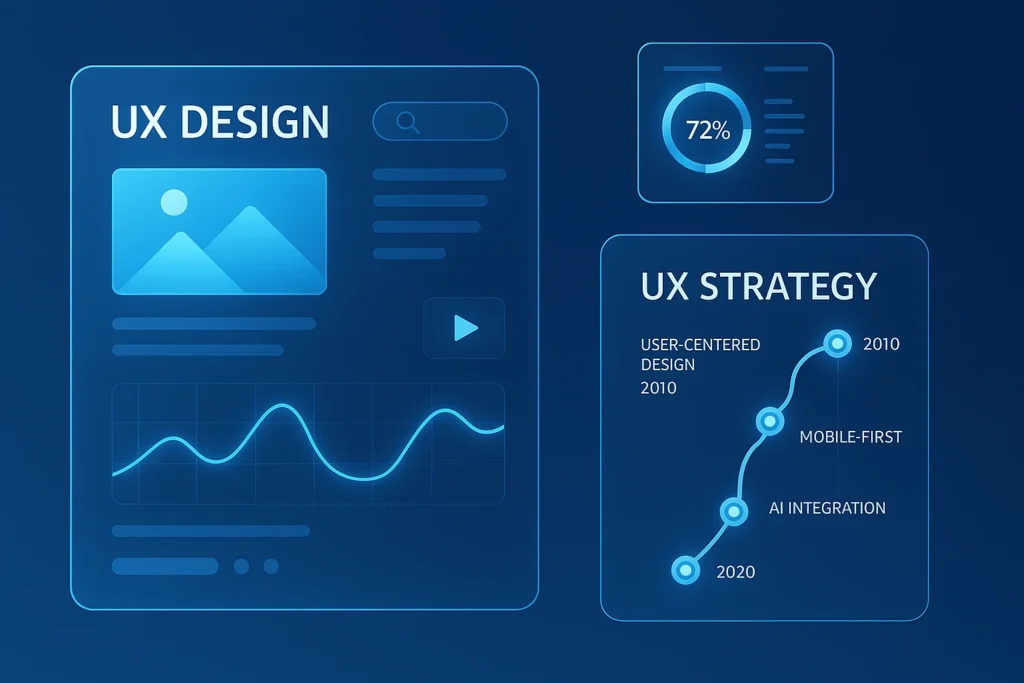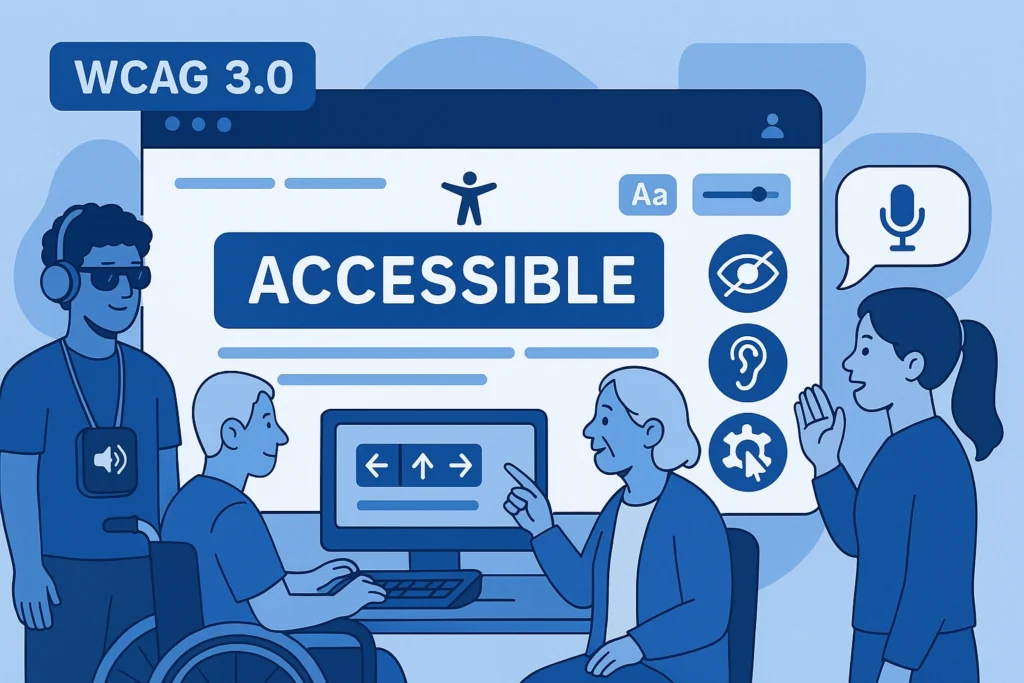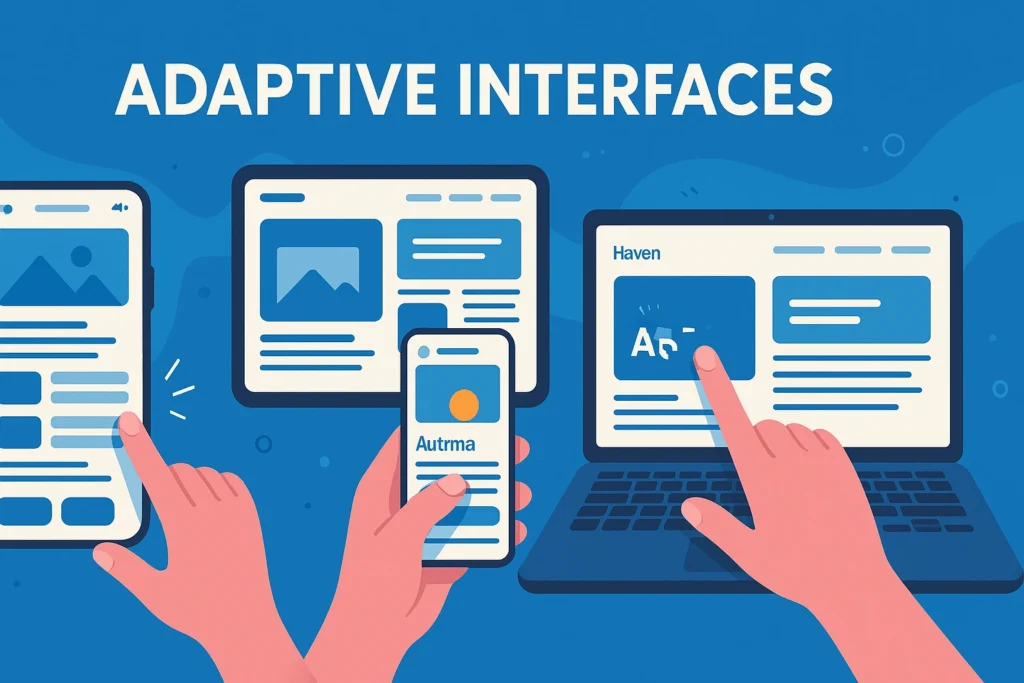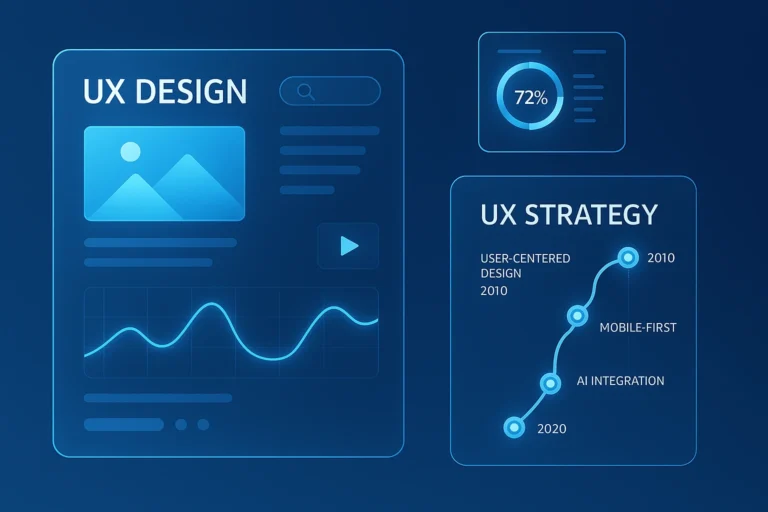Is Your UX Strategy Ready to Meet 2025’s UX Best Practices in 2025

In today’s fast-evolving digital landscape, crafting exceptional user experiences (UX) isn’t just a luxury—it’s a necessity. As technology rapidly evolves and user expectations soar, UX design in 2025 must be both adaptive and empathetic, placing the user right at the center of every digital interaction. Recent data shows that 88% of users are less likely to return after a poor digital experience (source: Toptal UX stats 2025), driving home the point that a seamless and thoughtfully designed interface can make or break customer loyalty.
Over the past five years, we’ve witnessed seismic shifts from static, one-size-fits-all interfaces to dynamic, data-driven ecosystems that anticipate and adapt to individual needs. Designers are embracing forward-thinking strategies—incorporating technologies like artificial intelligence (AI), machine learning, and advanced analytics—to create personalized and human-centered digital experiences. In this article, we’ll explore actionable insights into the latest UX best practices expected to dominate 2025, ensuring your digital products not only meet but exceed user expectations.
1. Hyper-Personalization in UX Design

The Rise of a Personalized Digital Ecosystem
The digital world of 2025 is all about personalization. With evolving user behaviors and expectations, personalized UX has moved from a buzzword to a core design principle. No longer are generic interfaces enough; users crave experiences that are tailor-made to their needs. The integration of AI and machine learning into design processes is transforming static pages into dynamic, adaptive interfaces that respond to individual behaviors in real time.
Key Elements of Personalized UX 2025:
- Adaptive Interface Design: Algorithms now analyze user behavior and keep a track of users interactions on website/software to adjust content layouts and navigation paths on the fly. These adaptive interfaces change in real time, ensuring that every interaction feels relevant to the user like this design is made personally for them.
- User-Centric Design: When designers pay attention to what each person likes and how they interact, they can craft experiences that feel personal—making people more likely to stick around and take action.
- Real-Time Behavioral Tracking: Modern technologies closely monitor how users interact online—tracking everything from mouse movements to click patterns and the time spent on each session. By analyzing this data, brands can craft personalized recommendations and content that genuinely connect with each individual. Take instagram or youtube in example your feed chances according to your engagements.
- Privacy-First Personalization: The latest GDPR updates for 2025 make it more crucial than ever to strike the right balance between personalized experiences and strong data protection. By maintaining transparent data practices, businesses can build trust while still making the most of valuable behavioral insights.
Research from industry leaders like the Nielsen Norman Group and Forrester has highlighted how personalized UX significantly boosts engagement and conversion rates. By integrating these strategies, companies create smooth, intuitive user experiences while fostering lasting connections with their audience.
2. Accessibility and Inclusivity as Standard, Not an Option

Designing for Everyone, Everywhere
Accessibility is no longer just an afterthought—it’s a core design priority in 2025. With WCAG 3.0 introducing higher standards for digital inclusivity, designers must ensure that every online experience is seamless and accessible for users of all abilities and backgrounds.
Modern Accessibility and Inclusivity Practices for Designing Best UX design:
- WCAG Updates: WCAG 3.0 guidelines have brought about detailed suggestions that encourage usability for all individuals with visual disabilities or people with cognitive disabilities so that they can also use the platform and fit in the society normally.
- Voice Navigation & Screen Readers: for all those who might struggle with traditional interfaces to explore content effortlessly modern UX designers should also focus on voice Navigation and screen rendering techniques.
- Gesture Recognition: With the integration of gesture-based controls and touch interfaces, users who rely on physical movement, rather than a mouse or keyboard, have an ever-improving experience.
- Inclusive Design for Neurodivergent Users: Recognizing the unique needs of neurodivergent individuals and underrepresented groups, modern design now incorporates clear layouts, reduced clutter, and sensory-sensitive options.
- Legal and Ethical Considerations: With growing legal risks for non-compliant sites, ensuring accessibility isn’t just about ethical design—it’s also a critical legal mandate.
Adhering to these principles not only helps avoid costly litigation but also enhances user trust and broadens your market reach. Statistically, accessible platforms see improved engagement, as users feel respected and considered, which in turn fosters greater brand loyalty.
3. Voice-First and Multimodal Interfaces

Embracing a New Interaction Paradigm
The digital interface of 2025 is evolving beyond traditional screen-based interfaces, It is now much more about voice, gesture, and multimodal interactions. With advancements in natural language processing (NLP) and voice recognition, users are rapidly switching towards voice-first and touchless interfaces, transforming how they engage with technology in their daily lives.
What This Means for Designers:
- Voice UX Design: Designing for Natural Conversations voice command has become an essential tool for smooth navigation demanding digital experiences that prioritize intuitive auditory interactions. Successful Voice UX design requires crafting natural language cues that feel conversational and effortless, enabling users to communicate with technology just as they would with a human assistant.
- Multimodal Interfaces: A Unified Approach to Interaction A truly immersive experience goes beyond voice—it integrates touch, visual, haptic feedback, and gesture controls, allowing users to switch effortlessly between input methods. For example, a user might initiate a search with a voice command and refine the results using touch or gesture-based interactions. Designing for fluid transitions between these modalities ensures an accessible and adaptable digital experience.
- Seamless Cross-Device Integration: Bridging voice-driven interactions with traditional visual interfaces requires harmonizing auditory and on-screen elements, ensuring a cohesive user experience. Voice commands should not only be accurately recognized but also logically linked to corresponding visual cues, creating a synchronized, responsive design that enhances usability across devices.
- Overcoming UX Challenges in a Voice-Driven World: The rise of cross-device interactions, particularly voice-to-visual experiences, presents unique challenges for designers. Ensuring consistency across smartphones, smart speakers, and wearable devices demands both creativity and technical expertise. To meet user expectations, designers must focus on responsiveness, contextual awareness, and adaptive feedback mechanisms, paving the way for a truly intuitive digital ecosystem.
- As users grow increasingly comfortable with conversational interactions and gesture-based commands, the traditional keyboard-and-mouse paradigm is gradually being replaced by a more natural, fluid model of engagement. Designers who embrace this transformation will be at the forefront of creating innovative, user-first experiences in the digital era.
4. Ethical UX: Transparency, Consent, and Trust

Building Digital Relationships on Trust
In a period of time where user data has become one of the most valuable commodities, the principles of UX design have taken center stage. Ethical UX 2025 revolves around transparency, consent, and the cultivation of genuine trust between brands and users.
Core Elements of Ethical UX: Building Trust Through Design
- Transparent Design: Users must understand what data is being collected and how their data is being used. Ethical UX relies on Clear disclosures and visual cues around data usage to make privacy policies easy to understand.
- Consent Flows: Manipulative design patterns that trick users into sharing data erode trust. Instead of resorting to manipulative dark patterns, ethical UX emphasizes consent-first approaches, strengthening brand loyalty in the long run.
- Trust-Driven UI Elements: Leading brands like Apple and Amazon have set benchmarks for clean, trustworthy design that prioritizes user privacy. Their interfaces reflect minimalism, trustworthy visuals, and clear communication around data practices.
- Visual Representation of Data Handling: Complex data flows can feel abstract, but visual representations of privacy policies and data handling fill the gap. Infographics, animations, and interactive elements can help users understand how their data moves through your platform.
- Balancing Personalization With Privacy: While personalized experiences driven by data are important, they shouldn’t violate the user’s privacy. This balance is central to designing interfaces that are both innovative and responsible with personal touch.
Why Ethical UX Matters Now More Than Ever
By positioning ethical considerations as the cornerstone of UX design, brands can differentiate themselves in a crowded digital marketplace. Consumers today are more savvy, and selective than ever before. Transparency, trust, and consent-first practices aren’t just checkboxes—they’re the foundation for sustainable success in modern UX design.
5. Micro-Interactions and Animation for Enhanced Engagement
Small Details That Make a Big Difference
Subtle micro-interactions and thoughtful animations can transform a standard digital experience into a memorable one. In 2025, one of the emerging trends in UX micro-interactions is the use of animations not just for aesthetics but to guide, inform, and reassure users throughout their journey.
Why Micro-Interactions Matter:
- Enhanced User Feedback: Micro-interactions provide immediate feedback for user actions. For instance, a subtle animation when a button is clicked reassures the user that their input was received.
- Reinforcing Rewards and Actions: Well-designed animations can celebrate small wins—such as a successful form submission or a completed transaction—making users feel more connected and positive about their interactions.
- Accessibility-Conscious Motion Design: Animations must be designed with accessibility in mind. Options to reduce motion for users with vestibular conditions or customizable animations ensure inclusivity.
- Tools and Frameworks: Designers now have access to a suite of advanced tools like Framer, Lottie, and Motion One, which simplify the integration of high-quality, responsive animations into digital products.
- Frameworks for Consistency: By using component-based design patterns and atomic design principles, designers can create a cohesive suite of micro-interactions that enhance usability while maintaining visual consistency across the board.
These small touches, while often overlooked, have a profound impact on overall user satisfaction, reinforcing that every detail in the user journey matters and contributes to the holistic digital experience.
6. Designing for Cross-Platform Consistency and Speed

The Imperative of a Unified Digital Experience
As users interact with digital products like websites, apps, software, online services on a huge variety of devices —from mobile phones and desktops to AR/VR and wearables like smart glasses (Meta glasses)—the need for consistent, high-performance UX design has never been more important. A responsive, mobile-first UX design that Focuses on performance is critical for retaining user engagement and minimizing drop-offs.
Optimizing for Speed and Consistency:
- Responsive UX Design: make sure that websites and applications adjust to different screen sizes and orientations. Consistent layouts, typography, and navigation ensure brand continuity and reliability.
- Mobile-First Approach: As we all know that today there are more mobile users than laptop users, designing for small screens first ensures that every user experience is polished and optimized. Google’s Core Web Vitals Prioritize speed, accessibility, and visual stability, all of which are very important in reducing bounce rates.
- Component Libraries and Atomic Design: Leverage scalable component libraries and adopt atomic design principles. By splitting a design into smaller units and reassembling them according to requirements by which teams can manage consistency across desktop, mobile, AR/VR, and wearables UI Design.
- Performance Optimization: Slow loading times can be Damaging. For example, research shows that mobile loading delays cause 53% of users to bounce (Google UX Benchmark). Thise fact shows that each millisecond counts toward user satisfaction.
Best Practices in Cross-Platform Design:
- Consistent Branding: Achieve a consistent look and feel through consistent imagery, color palette, and language across all devices.
- Testing and Iteration:Execute strict cross-device testing procedures and perform iterative design sprints to Fix performance problems on many different platforms.
- User-Centered Adaptations: Adapt some design elements for particular platforms without compromising the overall unified experience. As an example, touch interfaces can make use of larger tap targets compared to those optimized for mouse input.
Offering a seamless, uniform user experience on every platform is no longer a choice but a requirement for staying competitive in today’s digital world.
7. The Role of UX Research and Continuous Feedback Loops
Iteration Driven by Empirical Insights
No matter how good looking and eye-catching a design, its true value emerges after the real-world testing and usages. UX designing is all about continuous improvement learning from the continuous loop of testing, feedback and iteration. making sure that gathering real information and understanding your users (or the problem) is happening at every key step of your design work.
Implementing Effective UX Research:
- Usability Testing 2025: To gather the best result and information you should consider both in-person and remote usability testing tools to collect Comprehensive feedback. These tools will help to provide insights into user behavior, pain points, and areas for improvement.
- Design Sprints and Agile Methodologies: Making fast improvements by doing intense, short design projects. allows teams to explore new ideas and also helps new features and gather immediate feedback. Adaptive approaches ensure that design changes can be implemented and tested quickly.
- Behavioral Analytics: Use morden advanced analytical tools to monitor how users interact with your UI. Heatmaps, session replays, and journey mapping all help in understanding of user needs and requirements.
- Remote Testing Tools: As the world moves toward remote work, the breakthroughs in testing tools now make it possible for a larger and more diverse set of participants. This makes it possible for the feedback to shape a universal and accessible design.
- Case Studies of Success: Numerous flagship brands have infused continuous feedback loops, leading to user-centric, iterative product refinements. These case studies provide an example for firms seeking to develop a culture of ongoing refinement.
Ongoing UX research not only identifies near-term usability problems but also encourages an evolutionary culture. It informs customers that their voices are heard and that the brand is dedicated to creating a digital experience that evolves with its audience.
Conclusion: Designing Tomorrow’s Experiences, Today
UX design in 2025 is not just about stellar visuals—it’s about an immersive, dynamic, and inclusive experience that respects both the capabilities of modern technology and the diverse needs of its users. As we’ve explored in this article, the future of UX hinges on several critical practices:




